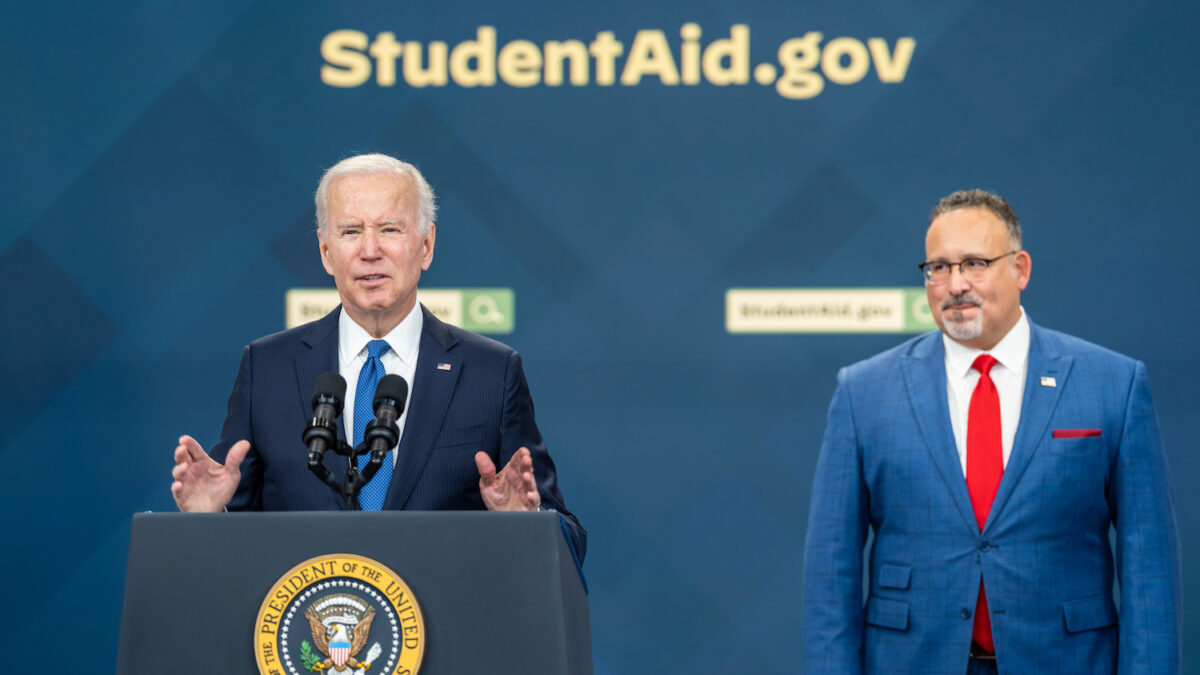The Biden administration faces off against a slew of states and two student loan debtors later this morning in the Supreme Court, hoping to justify its cancellation of some $400 billion in student loans. Much more is at issue, however, than the free money giveaway the president launched shortly before the midterm elections: Our constitutional separation of powers is at stake in the twin cases of Biden v. Nebraska and Department of Education v. Brown.
The Nebraska and Brown cases both concern challenges to the Department of Education’s plan to cancel $10,000 in student loan debt, increased to $20,000 for Pell Grant recipients, for individuals making under $125,000, or married taxpayers earning less than $250,000. The Department of Education premised its authority to cancel the loans on the “HEROES Act” Congress passed following the terrorist attacks on 9/11.
HEROES Act
The HEROES Act granted the Department of Education authority to “waive or modify any statutory or regulatory provision applicable to the student assistance programs” when the secretary deems it “necessary in connection with a war or other military operation or national emergency…”
Because the HEROES Act defines the term “national emergency” to include “a national emergency declared by the President of the United States,” the Biden administration maintained that its secretary of education can “modify” the student assistance programs by canceling the student loans, as proposed in its regulations.
In Biden v. Nebraska, six states led by Nebraska’s Republican attorney general sued the Biden administration, arguing the secretary of education lacked authority under the HEROES Act to cancel the student loans. The plaintiffs in Department of Education v. Brown, Myra Brown and Alexander Taylor, who both held student loans but neither of whom qualified for the full $20,000 in forgiveness, likewise sued, arguing the secretary of education exceeded his HEROES Act authority.
Brown and Taylor also claim the agency acted arbitrarily in establishing the parameters of the program, with Brown saying that barring her from participating because her loans are held by commercial lenders is unreasonable. Meanwhile, Taylor claims it was unreasonable to limit him to $10,000 in loan forgiveness merely because he never received a Pell Grant.
After the Eighth Circuit Court of Appeals and a federal court in Texas froze the Biden administration’s loan cancellation plan, the Supreme Court agreed to expedite the appeal, and on Tuesday morning justices will hear oral arguments in the cases.
During today’s hearing, the preliminary question for the court concerns “standing,” or whether the plaintiffs have an “injury” sufficient to allow them to sue. Significantly, when there are multiple plaintiffs involved in a case, such as in the Nebraska case, only one plaintiff needs to establish a concrete injury for standing to exist.
In their lawsuit, the six states — Arkansas, Iowa, Kansas, Missouri, Nebraska, and South Carolina — assert a variety of injuries, from Missouri’s lost revenue caused by fewer student loans, to other states’ reductions in tax dollars by virtue of the immediate loan forgiveness that is not taxable now but would be in the future.
Brown and Taylor argue the Department of Education’s failure to follow the appropriate notice and comment procedures for adopting the regulations injured them by limiting their ability to convince the secretary of education to expand the reach of the program to include their loans.
While it is impossible to know with certainty how the justices will rule, the plaintiffs present strong arguments for standing, meaning the Supreme Court will ultimately resolve the more important issue: whether, in forgiving the student loans, the secretary of education exceeded his authority under the HEROES Act.
And here, the question for the high court is not merely a $400 billion question, but one of grave constitutional dimension that hides beneath the cryptically named “major questions doctrine.”
Major Questions Doctrine
Under the major questions doctrine, when an administrative agency, like the Department of Education, claims the “power to make decisions of vast ‘economic and political significance,’” the agency must be able to point to “clear congressional authorization.” The forgiveness of some $400 billion in student loans seems sure to qualify in the justices’ view as a decision of “vast economic and political significance.” And, thus, to withstand scrutiny, the Biden administration will need to establish that the HEROES Act clearly authorized the cancellation of the student loans.
The circumstances of this case strongly suggest the high court will say the secretary exceeded his authority and thereby strike the loan forgiveness plan. But equally important will be any guidance the Supreme Court provides.
When the court last addressed the “major questions doctrine,” Justice Neil Gorsuch, in a concurrence joined by Justice Samuel Alito, noted the doctrine “operates to protect foundational constitutional guarantees” and “to protect the Constitution’s separation of powers.”
In Article I, Gorsuch stressed, “the People” vested “all federal legislative powers in Congress.” That means the “important subjects … must be entirely regulated by the legislature itself,’ even if Congress may leave the Executive ‘to act under such general provisions to fill up the details.’” The concurrence continued:
The Constitution’s rule vesting federal legislative power in Congress is ‘vital to the integrity and maintenance of the system of government ordained by the Constitution’ … vital because the framers believed that a republic — a thing of the people — would be more likely to enact just laws than a regime administered by a ruling class of largely unaccountable ‘ministers.’
While Gorsuch’s exposition on the constitutional separation of powers came in a concurrence, it provided a roadmap for the Supreme Court to put an end to the administrative state. And Biden v. Nebraska and Department of Education v. Brown now provide the vehicle for the high court to get there.
Today’s oral argument will give a hint of whether the originalist majority intends to start in that direction.









